Are you trying to torch maximum calories, shed fat, become leaner, and generally improve your physique? Then a dumbbell HIIT workout may just be what you’re looking for.
A dumbbell HIIT workout is a type of training method that utilizes light-moderate dumbbell weights. It involves performing short bursts of intense dumbbell exercises with short rest periods. Dumbbell HIIT workouts are effective for building muscle, losing weight, and increasing muscle definition.
At the height of my bulking phase, I reached 18% body fat and desperately needed to shed those love handles.
I’ve been the sucker who spent countless hours on the treadmill with no results to show for, so I know how frustrating it can be.
But then I discovered weighted HIIT workouts, and it completely flipped my results (in a positive way).
If you’re interested in learning how I did it then stick around.
This post shares my research and experience in using dumbbell HIIT training to build a leaner body.
Let’s go!
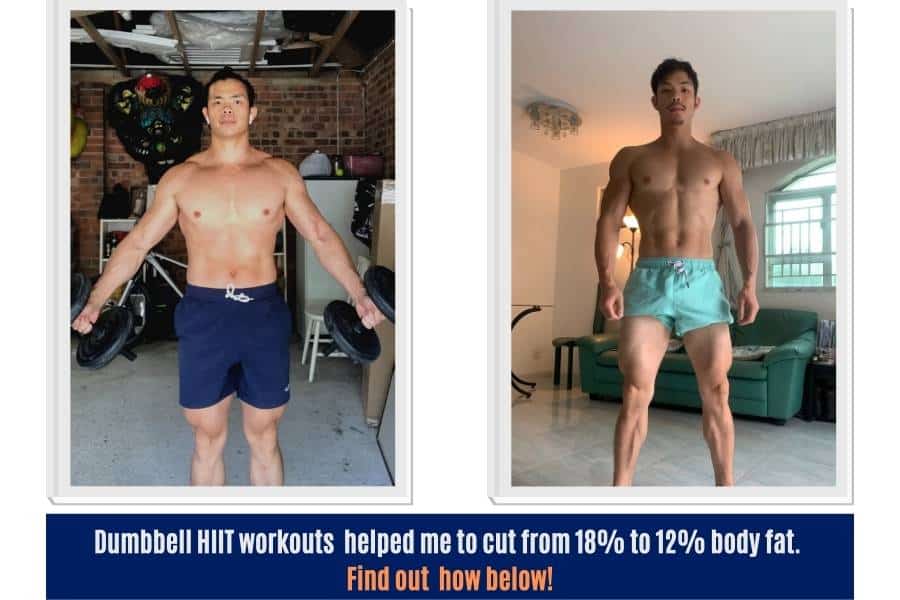
- What Is A HIIT Workout With Dumbbells?
- Advantages And Disadvantages Of HIIT With Dumbbells
- A 20 Minute Full Body Dumbbell HIIT Workout For Beginners
- What Weight Should You Use For Dumbbell HIIT?
- How To Tell If Your Dumbbell HIIT Workout Is Working?
- How Long Should A Dumbbell HIIT Workout Last?
- How Often Should You Do HIIT?
- How Effective Is Dumbbell HIIT?
- What Is The Best Time To Do A HIIT Workout?
- What Results Can You Expect From A Dumbbell HIIT Workout?
- How Soon Can You See Results From HIIT?
- How Can You Do Dumbbell HIIT At Home?
- Conclusion
What Is A HIIT Workout With Dumbbells?
Dumbbell high-intensity interval training (HIIT) workouts alternate between short bouts of vigorous dumbbell exercises and rest periods. This type of dumbbell training combines cardio with strength training to burn maximum calories and gain muscle. It is a great way to build a leaner physique.
What’s the difference between a conventional dumbbell workout and a HIIT dumbbell workout?
Well, a traditional dumbbell workout focuses on lifting as much weight as possible to build strength and muscle.
In contrast, the focal point of a HIIT dumbbell workout is to do as many repetitions in the shortest period to increase heart rate and work the cardiovascular system.
HIIT workouts in general are a great way to burn maximum calories in the shortest time possible.
And when you combine HIIT with weights, such as dumbbells, you also add resistance training aspects to your HIIT workout.
Result?
Dumbbell HIIT is a type of hybrid workout that is great for torching calories, strength conditioning, and building lean muscle mass.
Advantages And Disadvantages Of HIIT With Dumbbells
Here’s an overview of the pros and cons of dumbbell HIIT:
| Advantages Of Dumbbell HIIT | Disadvantages Of Dumbbell HIIT |
|---|---|
| Dumbbells are relatively cheap weights | Requires dumbbells to perform |
| It burns a lot of calories in a short period | Can be very intense for beginners |
| A rapid heart rate increase is great for cardio | Requires good lifting form to prevent injury |
| Increases resting metabolism | Dynamic movements can be difficult for beginners |
| Effective for increasing muscle tone and definition | Beginners can experience post-workout muscle soreness |
| Requires less than 10 square feet of space | Requires an area of open space for safety |
Let’s expand on one point in particular- “increases resting metabolism”.
This is something many of us want- the ability to burn more calories whilst doing absolutely nothing.
And that’s exactly what a dumbbell HIIT workout can do for you
You see, dumbbell HIIT leads to a phenomenon called excess post-exercise oxygen consumption (EPOC).
“HIIT and resistance training is the best way to promote EPOC.”
Pete McCall, ACE Fitness.
And EPOC, also known as “Afterburn”, has been shown to last for up to 48 hours.
So if you want to burn more passive calories at rest, then dumbbell HIIT can help you do just that!
It occurs as a result of your body drawing calories and nutrients to repair the muscle damage that occurs with intense weight lifting.
A 20 Minute Full Body Dumbbell HIIT Workout For Beginners
Now for the good stuff.
Here’s a 20-minute total body HIIT workout for beginners to do with dumbbells:
| Dumbbell Exercise | Reps | Sets | Inter-Set Rest | Weight |
|---|---|---|---|---|
| Goblet squat | 20-second AMRAP | 8 | 10-seconds | 35% of 1-rep max |
| Dumbbell floor press | 20-second AMRAP | 8 | 10-seconds | 35% of 1-rep max |
| Dumbbell swing | 20-second AMRAP | 8 | 10-seconds | 35% of 1-rep max |
| Renegade Rows | 20-second AMRAP | 8 | 10-seconds | 35% of 1-rep max |
| Clean to press | 20-second AMRAP | 8 | 10-seconds | 35% of 1-rep max |
AMRAP means “as many reps as possible”. So a 20-second AMRAP requires you to repeat the same exercise as many times as you can for 30 seconds.
You’ve finished 1 set after you’ve completed your 20-sec AMRAP.
Now take a 10-second rest and repeat 8 times to complete the respective exercise.
Do the same for each of the 5 exercises. Take a 1-2 minute rest in between exercises if you need.
Each exercise should take you 4 minutes to complete (including the res duration).
Therefore the entire workout should take you 20 minutes to complete (longer if you take a rest in between exercises).
Here’s how to do each exercise:
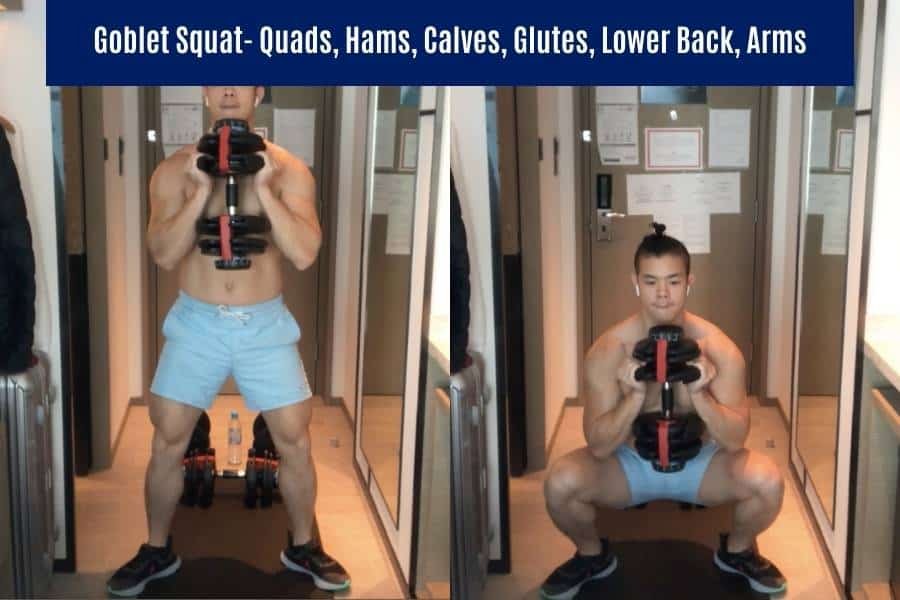
1) Goblet squat.
The dumbbell goblet squat is a core movement in many weighted HIIT programs. It will blast your entire lower body as well as work your lower back and arms as they stabilize the dumbbell.
How to do it:
- Hold a single dumbbell vertically and tight to the chest using the palms of both hands.
- Keep your elbows tucked into your torso.
- Squat down until the thighs are parallel to the floor.
- Drive upwards with the legs.
- Keep your back straight and your head up throughout.
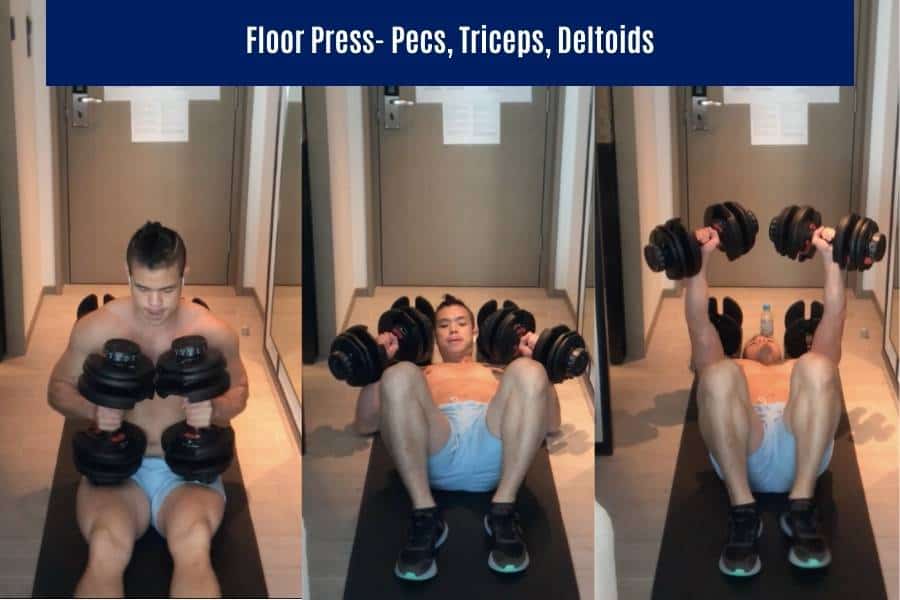
2) Dumbbell floor press.
No workout is complete without an upper-body pushing exercise that works the pecs, arms, and shoulders. The dumbbell floor press is one of the most effective and cheapest ways to train these muscles without a weight bench. At the very least, you’ll probably want a cheap yoga mat to lay on though.
How to do it:
- Sit on the floor with your legs out straight.
- Clasp 2 dumbbells vertically on each thigh.
- Lean back to lie on the floor whilst stabilizing the dumbbells above the nipples.
- Keep the elbows tucked close to the torso.
- Press both dumbbells upwards at a shoulder-width apart
- Slowly lower the dumbbells back down until your upper arms lay parallel to the ground.
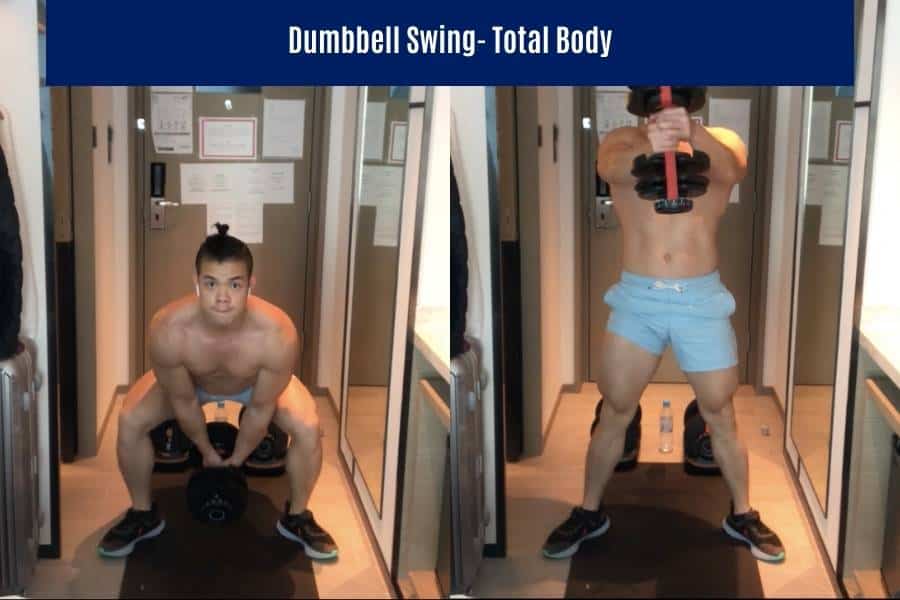
3) Dumbbell swing.
This dynamic dumbbell exercise mainly works the posterior-chain muscles (lower back, glutes, and hamstrings). But the arms, shoulders, upper back, and core are also recruited to hold the dumbbell.
How to do it:
- Use both hands to firmly clasp one end of a dumbbell that’s sitting vertically on the floor.
- Take a foot stance that’s just wider than shoulder-width apart.
- Extend the legs to lift the dumbbell off the ground whilst thrusting the hips forward to help you swing the dumbbell up.
- Contract your glutes as the dumbbell reaches peak height (eye-level).
- Allow the dumbbell to drop down and in between the legs, using the arms to control the fall (dumbbells shouldn’t bang on the floor).

4) Renegade row.
The renegade row activates the biceps and back on the side that’s lifting the dumbbell. In contrast, the supporting side works the arms and core in an isometric manner (similar to a plank). By alternating your row between both arms, you’ll emphasize upper body pulling strength as well as cardiovascular fitness.
How to do it:
- Get in a push-up position with your hands holding dumbbells on the floor (dumbbells should be running in line with your body).
- Use one arm to row one dumbbell towards the chest whilst keeping the non-rowing arm straight to support your body.
- Slowly lower the dumbbell to the floor.
- Repeat the row using the other arm.
- Alternate the row between both arms.

5) Clean to press
This is another dynamic total-body exercise that builds strength and gives you a good cardiovascular workout when applied in a HIIT-style workout. It’s a hybrid between the deadlift and shoulder press, mainly working the posterior chain, arms, and shoulders. But the quads and core are also engaged to stabilize the dumbbell. A yoga mat is recommended to protect your floor and dumbbells.
How to do it:
- Place two dumbbells beside both feet.
- Bend down to clasp the dumbbells in both hands (keeping your back straight).
- Explode upwards by extending your legs and thrusting your hips forward.
- Lift the dumbbells to shoulder-level as you explode upwards.
- Press the dumbbells up by extending the arms.
- Lower the dumbbells back to shoulder level.
- Allow the dumbbells to drop to your side and lower them back down to the floor.
How to Reduce The Workout To 10 Minutes Or Increase To 30 Minutes
I designed this workout based on my abilities as a beginner. And it worked well for me.
But you may have higher or lower levels of fitness.
As such, you may want to increase or decrease the workout duration accordingly.
To cut this dumbbell HIIT workout to 10 minutes- do 4 sets per exercise instead of 8 sets.
To lengthen the dumbbell HIIT workout to 30 minutes- add extra moves whilst maintaining 8 sets per exercise.
Other good dumbbell HIIT exercises to add to your workout include:
- Dumbbell forward lunge. Works the posterior chain, quads, and arms.
- Squat to press. Works the legs, shoulders, arms, and core.
- Russian twist. Works the core, arms, and shoulders.
- Weighted sit-up or crunch. Works the core.
- Dumbbell deadlift. Works the whole body.
All of the exercises given will work the abs and core to some degree. And in my opinion, dedicated ab exercises aren’t necessary for a toned midsection. But you can always try the weighted crunch and Russian twist if you enjoy doing them!
You may also be interested in my other article to find out about the best exercises for a dumbbell workout.
What Weight Should You Use For Dumbbell HIIT?
The generally recommended dumbbell weight for HIIT is 35% of the 1-repetition maximum for a given exercise. This roughly equates to 15lbs (7.5kg) for the average male beginner or 7lbs (3kg) for a female beginner. Individuals with higher weight training experience should use heavier dumbbells.
The table below shows my HIIT dumbbell weight recommendations for different training levels:
| Training Level | Male Recommended HIIT Dumbbell Weight | Female Recommended HIIT Dumbbell Weight |
|---|---|---|
| Beginner | 15lbs (7.5kg) | 7lbs (3kg) |
| Novice | 20lbs (10kg) | 15lbs (7.5kg) |
| Intermediate | 30lb (15kg) | 20lbs (10kg) |
| Advanced | 50lbs (25kg) | 30lbs (15kg) |
These recommendations are based on my 10-year male dumbbell training experience, the fact that females have ~35% less strength compared to men, and the user-generated strength standards on the Strength Level database
If you don’t have any dumbbells yet, then I highly recommend the Hola Hatha set for women and Papababe set for men.
Both are durable and ideal for HIIT workouts.
If you’re interested, you can check out my other article for more information on how heavy your dumbbells should be for HIIT.
How To Tell If Your Dumbbell HIIT Workout Is Working?
Monitoring heart rate is the most reliable way to determine if a HIIT workout is working. During peak intensity, the heart rate should increase to approximately 70 to 90% of the maximum heart rate. This equates to around 130 to 170 beats per minute for a 30-year-old individual.
To calculate your maximum heart rate: take 220 and subtract your age.
30 year old example: 220 – 30 = 190 BPM (beats per minute) maximum heart rate.
To get 70-90% of the maximum: multiply your maximum heart rate by 0.7-0.9.
30 year old example: 190 x 0.7 to 0.9 = 133 to 171 BPM recommended HIIT heart rate.
And how exactly do you keep track of your heart rate in the middle of a body-blitzing workout?!
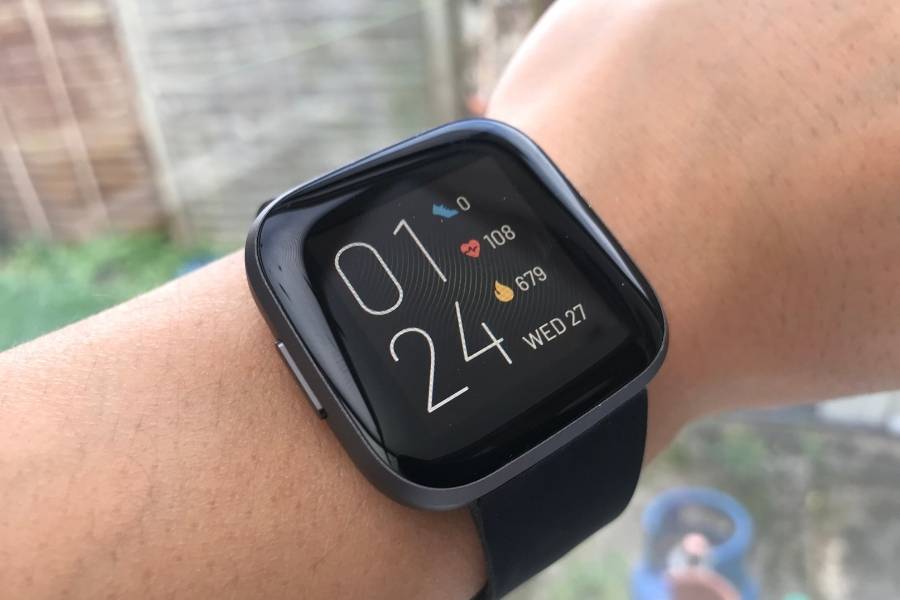
You could do it the old-school way by using your fingers to track your pulse.
But a fitness watch is highly recommended for convenience and accuracy.
I use the Fitbit Versa.
However, if you’re looking for a cheap alternative that can measure both heart rate and calories burned, then the Fitbit Inspire works just as well for half the price.
You can check out my other article to find out how to know if you are doing HIIT right.
How Long Should A Dumbbell HIIT Workout Last?
A typical HIIT workout should last between 10 to 30 minutes. People with less exercise experience should stay closer to 10 minutes, whilst those who have more experience should stay closer to 30 minutes. It is recommended to begin increasing resistance when a 30 minute HIIT workout becomes easy.
| Training Level | 10 Minute HIIT Enough? | 20 Minute HIIT Enough? | 30 Minute HIIT Enough? |
|---|---|---|---|
| Beginner | Yes | Yes | Yes |
| Novice | Yes | Yes | Yes |
| Intermediate | No | Yes | Yes |
| Advanced | No | No | Yes |
Please note that these are just guidelines.
In reality, your dumbbell HIIT workout duration will be affected by how well you execute the exercises and the weight of your dumbbells.
For example:
A beginner who isn’t lifting enough weight, or is only performing the exercises with a partial range of motion, will likely not gain the full HIIT benefits from a 10-minute workout.
Likewise, an advanced lifter can still get an effective 10-minute HIIT workout if their dumbbell is very heavy and the exercises are completed with a full range of motion.
Therefore listening to your own body, actively being aware of your fatigue levels, and keeping track of heart rate is the most reliable way to tell if you’re dumbbell HIIT workout is long/intense enough.
How Often Should You Do HIIT?
Generally speaking, the average person can safely perform between 1-4 HIIT workouts per week. But this depends on whether or not other weight training programs are being implemented alongside a HIIT program. It is not recommended to do more than 5 intense workouts per week.
You can refer to my table below to determine how to structure a beginner’s dumbbell HIIT program alongside a traditional weight/strength training program.
| + 1 weekly strength workout | + 2 weekly strength workouts | + 3 weekly strength workouts | + 4 weekly strength workouts | + 5 weekly strength workouts | |
|---|---|---|---|---|---|
| 1 weekly HIIT workout | OK | OK | OK | OK | Too Much |
| 2 weekly HIIT workouts | OK | OK | OK | Too Much | Too Much |
| 3 weekly HIIT workouts | OK | OK | Too Much | Too Much | Too Much |
| 4 weekly HIIT workouts | OK | Too Much | Too Much | Too Much | Too Much |
| 5 weekly HIIT workouts | Too Much | Too Much | Too Much | Too Much | Too Much |
As a general rule, you should avoid doing more than 5 intense weight workouts per week, especially as a beginner.
Doing so increases your risk of overtraining and injury.
If you’re not doing strength training on the side, then you can get away with performing 4 or 5 HIIT workouts per week.
But if you are doing additional strength workouts (i.e. lifting heavy to build strength and tone muscle), then you can follow the guidelines above.
Once you’ve reached the intermediate stages of training (around 2 years), then you’ll likely be more adapted to increasing the number of workouts you can perform per week.
How Effective Is Dumbbell HIIT?
Dumbbell HIIT workouts are highly effective for people who are looking for a balance between cardiovascular training, fat-burning, muscle-building, and strength conditioning. This makes dumbbell HIIT good for those who are training to increase tone, add muscle definition, and build a leaner body.
Now, HIIT workouts in general are great for overall body conditioning.
And dumbbells supercharge this effect.
Whilst dumbbell HIIT may not be as effective as a traditional heavy dumbbell workout for building maximum muscle and strength, it’s by no means useless for this application.
In fact, by using moderate-weight dumbbells, beginners can effectively build a foundation of muscle.
Furthermore, the main advantage of doing HIIT with dumbbells lie how many calories HIIT burns:
| Exercise Type | Typical Calories Burned In 30 Minutes | Muscle-Building Potential |
|---|---|---|
| Dumbbell/kettlebell HIIT | 450 cal | High |
| Bodyweight HIIT | 306 cal | Moderate |
| Heavy dumbbell workout | 216 cal | Very High |
| Kickboxing | 360 cal | Moderate |
| Moderate cycling on a machine | 252 cal | Moderate |
| Moderate rowing on a machine | 252 cal | Moderate |
| Intense running at 7.5mph | 450 cal | Low |
| Light running at 5mph | 288 cal | Low |
You can see that a dumbbell HIIT workout is not only generally better than other types of cardio exercises for burning calories, but it’s also much more effective for building muscle and tone too.
If you’re interested, you can check out my other article to find out what dumbbell weight is best for toning the arms.
What Is The Best Time To Do A HIIT Workout?
HIIT is best performed either in the morning before breakfast or 2 hours after any main meal. Those who are aiming to lose fat should go for the former option. In contrast, those who are doing HIIT to maximize cardiovascular fitness should go for the latter option.
What’s the premise behind these recommendations?
If you’re looking to shed fat, then a pre-breakfast workout will torch body fat since you’re exercising in a fasted state (disclaimer- it’s hard work!)
But if you’re looking to increase your cardiovascular capacity, then doing HIIT after you’re properly fueled will help you to push harder and for longer.
Additionally, you shouldn’t exercise within 2 hours of consuming any main meal in general.
That’s because it takes your body around 2 hours for the consumed food to begin fully digesting and for the body to start extracting the carbohydrates and energy from the food.
What Results Can You Expect From A Dumbbell HIIT Workout?
HIIT workouts are generally great for burning fat and losing weight. Adding free weights such as dumbbells or kettlebells to a HIIT workout can further increase the effectiveness of the workout to help an individual build muscle definition, strength, get ripped, and tone.
So you can see that HIIT workouts are extremely versatile.
If your goal is to simply lose some belly or arm fat, then you can stick to a standard bodyweight HIIT program.
But if you also want to build some lean muscle and definition along the way, then adding dumbbells to your HIIT program is the way forward.
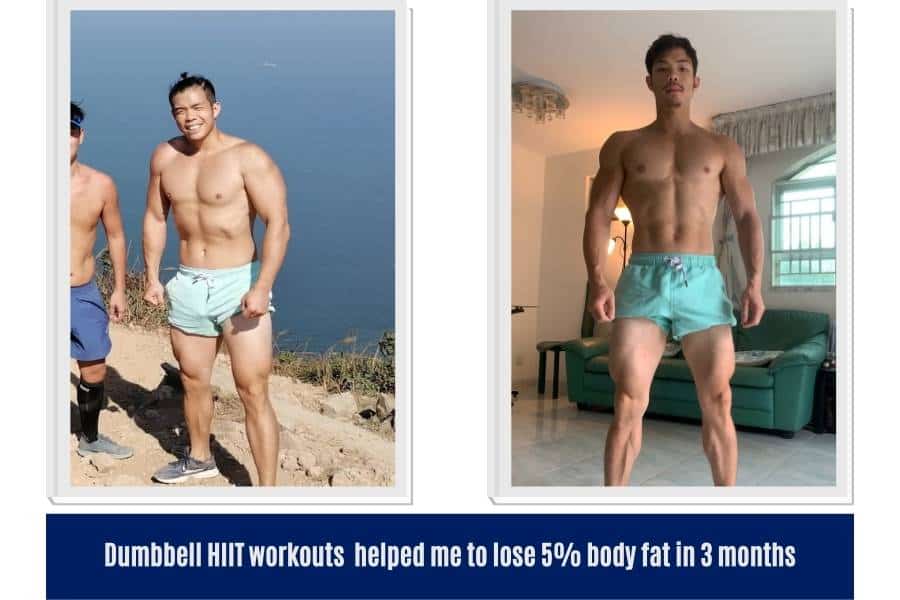
Dumbbell HIIT workouts are also great for bodybuilders who are looking to burn fat whilst maintaining muscle after a bulking phase.
This is exactly what I did.
You can see that my body fat percentage fell whilst retaining my muscle.
As a result, I became leaner, toned, and more defined.
If you like, you can go to my other article to find out what dumbbell weight is best for gaining muscle!
How Soon Can You See Results From HIIT?
The average beginner should begin to see results within 1 to 2 months of starting a HIIT program. The exact time required to notice the first effects of HIIT training will depend on the training goal. The onset of fat loss will come sooner than the onset of muscle gain.
This is based on my personal experience and the fact that the average 150lb person can lose around 3lbs of fat per month and gain around 2lbs of muscle per month.
“It took me 3 months of consistent dumbbell HIIT workouts and a disciplined diet to go from a bulky physique into a lean and toned one.”
Kal, Kalibre Fitness
But generally speaking, you should begin to see a slightly slimmer waistline and more arm definition by the end of month 1.
By the end of months 2 and 3, you’re likely to notice increased definition across your entire body (including the abdominal area).
Of course, how effectively you see results will vary greatly depending on your ability to push yourself during the workout and maintain disciplined in your diet post-workout.
Here’s an outline for recommended nutrition intake for different goals:
| Nutrient | Build Lean Muscle & Tone | Lose Fat & Increase Definition |
|---|---|---|
| Calories | Maintenance calories | -5 to -10% caloric deficit |
| Protein | 1.2 grams per pound bodyweight | 1.2 grams per pound bodyweight |
| Carbohydrates | 2.5 grams per pound bodyweight | 2.0 grams per pound bodyweight |
| Fats | 0.4 grams per pound bodyweight | 0.3 grams per pound bodyweight |
If you’re looking to build muscle, then you may be interested in my other article which explains how to gain your first 10-pounds of lean muscle!
How Can You Do Dumbbell HIIT At Home?
To wrap things off, here’s a list of recommended equipment for you to do your own HIIT dumbbell workout at home.
These products aren’t necessarily the most premium on the market. They’re simply what I found to be the most cost-effective
They worked great for me and they’re the products I recommend to my friends and family.

1) Moderate Weight Dumbbells
The dumbbells I use in this post are the Bowflex 552 (see my full-review here).
Whilst they are great dumbbells for building a good amount of muscle at home (they go up to 52.5lbs per dumbbell in 5lb increments), they are a bit pricey for solely-HIIT purposes.
That being said, they are versatile dumbbells that can be used for anything. So if you have ambitious long-term muscle-building goals, then by all means go for them.
But if you’re looking for a cheap and durable dumbbell set for just HIIT purposes, then I recommend these hex dumbbells instead:
- Hola Hatha handweight set for women.
- Papababe fixed-weight set for men.
The Hola Hatha’s go up to 15lbs (7.5kg) per dumbbell. In contrast, the Papababe’s go up to 25lbs (12.5kg) per dumbbell.
Both sets will last for at least 2 years of solid HIIT progression and that’s enough to take a female/male beginner to the intermediate stages of training.
For more information on dumbbell prices, you can check out my other article to learn more about the average price per pound of different dumbbell types.

2) Yoga Mat
A good mat like this Balance From will protect your floor and dumbbells.
A mat will also prevent your sweat from going everywhere (and trust me you’ll be sweating buckets if you’re doing HIIT properly).
If you have a large carpet cutting or something similar, then you can use that instead.
3) Fitness Watch
A good fitness watch like the Fitbit Inspire is an affordable way to accurately keep track of your heart rate.
Remember- this is the best way to tell if you’re working hard enough in your HIIT workouts.
You could check your heart rate manually by using the two-finger pulse method.
But from my experience, this is too cumbersome.
Don’t forget that the whole premise of dumbbell HIIT workouts is to quickly increase your heart rate with quick bouts of exercise that often change quickly.
Without a watch, it’s hard to stick to your HIIT workout and measure heart rate simultaneously.
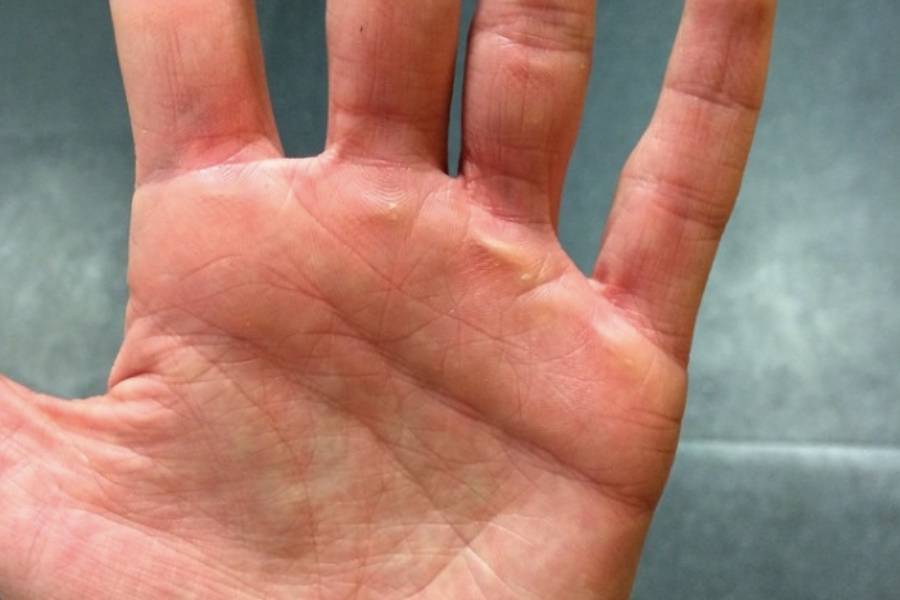
4) Gloves (if you don’t want calloused hands)
These are entirely optional.
If you’ve never lifted weights before, then you’re likely to develop blisters on the palm of your hands. Over time, these will turn into hardened callouses.
Cheap gloves like the Ihuan neoprene’s will prevent this from happening.
Conclusion
I’ve shared the ultimate guide to doing dumbbell HIIT workouts.
This post explains what it is, how to do it, and why it’s so effective for building lean muscle and losing fat.
Dumbbell HIIT workouts are one of the most cost-effective as well as time-effective ways to tone your body and increase muscle definition.
People don’t build their dream physiques on the treadmill.
So what are you waiting for?!
Will you be trying the Kalibre HIIT dumbbell workout? How did it go?
Feel free to send me a message if you have any questions! You can find my details on the “contact us” page.
You may also be interested in the downloadable Kalibre Blueprint PDF which details exactly how I gained 40lbs of lean muscle (it’s 100% free!). It details the exact exercises and nutrition (with printable worksheets) I used to go from skinny to ripped!
Thanks for reading guys!
Peace Out,
Kal
(Biochemistry BSc, Biomedical Sciences MSc, Ex-Skinny Guy)


